So I had some good feedback in my project log (link in sig  ) on my post about rad cleaning and people who haven't see that may find this useful.
) on my post about rad cleaning and people who haven't see that may find this useful.
It isn't really a review a such, just how I used the kit in my own way to clean my new XSPC RX480 V3 rads.
Why should we clean radiators?
New radiators pretty much always have leftover flux inside them from the manufacturing process, just washing through with water will remove some of the loose bits but there will be lots of bits stuck to the inside which will dislodge over time and could get stuck in the fine fins on your waterblocks.
This always happens to me no matter how well I clean my rads with distilled vinegar and hot water, after a year or so I check and there are black bits in my blocks!
This pick-up can also affect the pH of the fluid which if coloured or dyed can altar the colours over time. Ever had nice vibrant coolant on day one and then liquid mud after a few months?
So this time I decided that having £400 worth of rads it wasn't too bad an idea to spend £25 on a kit to clean them.
Lots of boring pH and TDS meter pictures incoming
Here is my rad cleaning setup, what a lovely sight!
Using a 1 litre plastic beaker with an Eheim aquarium pump, some clean unused 1/2 ID tube and fittings with cable ties.
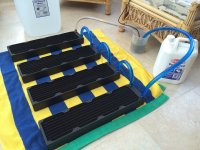
Here is the Mayhems kit
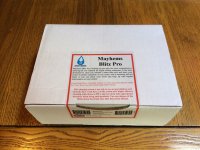
And these are all the bits you get
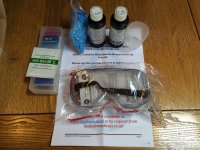
So to start off I went about calibrating the pH meter and to do this I used some RO DI 0 TDS (Total Dissolved Solids) water, I used the provided measuring cup to measure out 250ml as my glass beaker is not accurate and only goes to 200ml on the scale.
(The TDS Meter is not included with the kit and is what I use for monitoring my RO filtration systems)
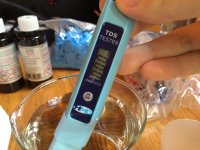
On the back of the Calibration Sachet is a table of pH levels at different temperatures.
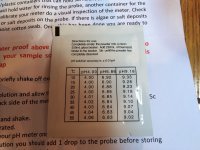
Mix in the sachet and stir until all the little bits have disolved
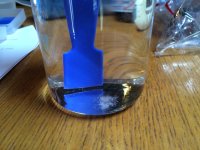
Let the meter adjust to the temperature and take a reading

23c would mean somewhere between 6.86 and 6.88 pH, unfortunately no matter how fine you adjust the screw on the meter it will only calibrate by 0.10 at a time. So I adjust it until it was flicking between 6.80 and 6.90 pH and left it at that.
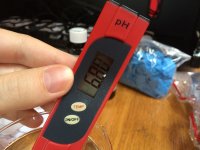
With that done I took a reading of clean DI water straight from the bottle.
004 ppm TDS and 5.50 pH

I then flushed a few litres of DI water through the rads to clean out any solid bits of which there was a few black bits per rad, nothing major though so on the face of it pretty clean rads from the factory. After that I left fresh DI water circulating for just over 24 hours with nothing added just to see what the water could pickup if I was running them like this in my system.
That resulted in the TDS rising to 34 and the pH to 6.5 so the water has picked up things from inside the rads after only 24 hours! Imagine running them for a year!
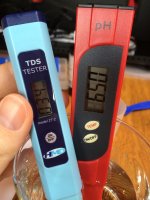
Next I flushed that water out and mixed up the full 100ml of the Mayhems Part 1 with approx 1900ml of DI Water
I checked the pH of the solution at the start of the 2 hour cleaning period and it read 2.10 pH, so almost at the desired 2.0 pH. I couldn't get a TDS reading as my meter gave an error at this pH level.

After 2 hours of shaking every 10-15min to try and dislodge anything resulted in a reading of 2.4 pH, I am no chemist but I guess the rise means things have dissolved into the acidic solution?
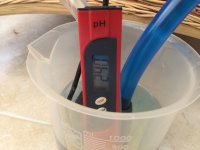
This is what the Part 1 looked like after 2 hours, all the brown stains in the bucket are from washing ferric hydroxide material used to remove phosphates in my fish tank so ignore that, the colour is what surprised me. I didn't get a good picture of the Part 1 starting colour but it wasn't this blue! There are quite a lot of little black bits floating about but it was very hard to get a picture with my camera.
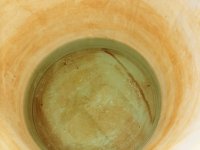
Next I pulled off the tubes and flushed a good 5 litres of RO DI through each rad to wash out all the Part 1 and during this period I found LOTS of very fine black bits in the water, too small to picture but I could see them! So not as clean as I initially thought! These bits are what Part 2 is meant to pick up and remove when it neutralises the acid but I gave a helping hand as I was surprised by just how much of it there was.
I then mixed up the Mayhems Part 2 pH neutraliser which as far as I can tell is basically a type of washing-up detergent to help suspend the particles in the fluid and flush them out as well as neutralise the acid.
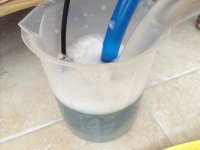
5min in with Part 2 and this is the pH reading of 5.40
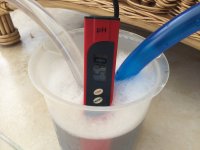
After 24 hours of circulation I was left with a pH of 7.10, nice and neutralised!
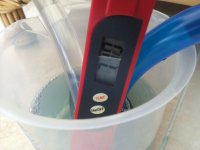
Now you have to clean out the rads to remove all of the Part 2, the instructions say to flush twice leaving 30min of circulation between goes.
I flushed a good 30 litres of water through the rads by putting the pump in a clean bucket of RO DI water and the drain tube into another. I then let it circulate for a bit and then flushed some more!
I had to flush each rad individually at least 5 times by filling up with a few hundred ml of RO DI and shaking like a mad man, it was the only way I could clean out all the fine black particles that the Part 2 didn't get. May be a little OCD but I wanted them as clean as possible.
I think the Part 2 would have worked better if I had used a stronger pump or maybe not all 4 rads in a row!
Finally no more bits or bubbles left from the Part 2 so I was happy to setup and fill the loop once more with the same bottled DI water from the pre cleaning test with readings of 004 ppm TDS and 5.50 pH and let it circulate again for 24 hours.
After 24 hours was up the final readings are 009 TDS and 7.80 pH
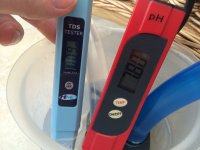
Now not being a scientist or anything I should have ran a control beaker because the pH and TDS of DI water can change just by being exposed to the atmosphere but I forgot to do that, I also was reusing the pump and tube from before so that could have caused a slight rise in TDS if they were slightly dirty.
Small warning, Do not use the Part 1 on your system, only outside of it to clean rads! Look what happens to nice new tube after only 2 hours:
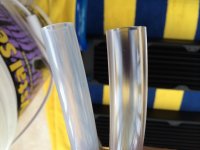
To conclude the results:
Bottled DI water readings: 004 TDS 5.5 pH
24 Hour Circulation before using Mayhems Kit : 034 TDS 6.5 pH
24 Hour Circulation after using the Mayhems Kit: 009 TDS 7.8 pH
What the difference in pH means I don't really know, quite neutral either way.
If I was going to do it all over again I would use a 50 or 100 micron filter sock under the outlet tube during the Part 2 to help pick out the fine particles during that stage rather than just recirculating them through the loop and having to flush them out manually afterwards!
Anyway, I am very happy and pretty sure I have the cleanest radiators possible and what I will be doing in the future once my loops are up and running is test the TDS and pH at the start and then test again after a few months just to see what if any change there is.
Finally, it would be good if OcUK could stock extra pH buffer calibration sachets and refills of Mayhems Part 1 and Part 2, I wouldn't want to buy the kit again as I don't need the extras but some top ups of the fluids would be nice.
 ) on my post about rad cleaning and people who haven't see that may find this useful.
) on my post about rad cleaning and people who haven't see that may find this useful.It isn't really a review a such, just how I used the kit in my own way to clean my new XSPC RX480 V3 rads.
Why should we clean radiators?
New radiators pretty much always have leftover flux inside them from the manufacturing process, just washing through with water will remove some of the loose bits but there will be lots of bits stuck to the inside which will dislodge over time and could get stuck in the fine fins on your waterblocks.
This always happens to me no matter how well I clean my rads with distilled vinegar and hot water, after a year or so I check and there are black bits in my blocks!
This pick-up can also affect the pH of the fluid which if coloured or dyed can altar the colours over time. Ever had nice vibrant coolant on day one and then liquid mud after a few months?
So this time I decided that having £400 worth of rads it wasn't too bad an idea to spend £25 on a kit to clean them.
Lots of boring pH and TDS meter pictures incoming

Here is my rad cleaning setup, what a lovely sight!
Using a 1 litre plastic beaker with an Eheim aquarium pump, some clean unused 1/2 ID tube and fittings with cable ties.

Here is the Mayhems kit

And these are all the bits you get

So to start off I went about calibrating the pH meter and to do this I used some RO DI 0 TDS (Total Dissolved Solids) water, I used the provided measuring cup to measure out 250ml as my glass beaker is not accurate and only goes to 200ml on the scale.
(The TDS Meter is not included with the kit and is what I use for monitoring my RO filtration systems)

On the back of the Calibration Sachet is a table of pH levels at different temperatures.

Mix in the sachet and stir until all the little bits have disolved

Let the meter adjust to the temperature and take a reading

23c would mean somewhere between 6.86 and 6.88 pH, unfortunately no matter how fine you adjust the screw on the meter it will only calibrate by 0.10 at a time. So I adjust it until it was flicking between 6.80 and 6.90 pH and left it at that.

With that done I took a reading of clean DI water straight from the bottle.
004 ppm TDS and 5.50 pH

I then flushed a few litres of DI water through the rads to clean out any solid bits of which there was a few black bits per rad, nothing major though so on the face of it pretty clean rads from the factory. After that I left fresh DI water circulating for just over 24 hours with nothing added just to see what the water could pickup if I was running them like this in my system.
That resulted in the TDS rising to 34 and the pH to 6.5 so the water has picked up things from inside the rads after only 24 hours! Imagine running them for a year!

Next I flushed that water out and mixed up the full 100ml of the Mayhems Part 1 with approx 1900ml of DI Water
I checked the pH of the solution at the start of the 2 hour cleaning period and it read 2.10 pH, so almost at the desired 2.0 pH. I couldn't get a TDS reading as my meter gave an error at this pH level.

After 2 hours of shaking every 10-15min to try and dislodge anything resulted in a reading of 2.4 pH, I am no chemist but I guess the rise means things have dissolved into the acidic solution?

This is what the Part 1 looked like after 2 hours, all the brown stains in the bucket are from washing ferric hydroxide material used to remove phosphates in my fish tank so ignore that, the colour is what surprised me. I didn't get a good picture of the Part 1 starting colour but it wasn't this blue! There are quite a lot of little black bits floating about but it was very hard to get a picture with my camera.

Next I pulled off the tubes and flushed a good 5 litres of RO DI through each rad to wash out all the Part 1 and during this period I found LOTS of very fine black bits in the water, too small to picture but I could see them! So not as clean as I initially thought! These bits are what Part 2 is meant to pick up and remove when it neutralises the acid but I gave a helping hand as I was surprised by just how much of it there was.
I then mixed up the Mayhems Part 2 pH neutraliser which as far as I can tell is basically a type of washing-up detergent to help suspend the particles in the fluid and flush them out as well as neutralise the acid.

5min in with Part 2 and this is the pH reading of 5.40

After 24 hours of circulation I was left with a pH of 7.10, nice and neutralised!

Now you have to clean out the rads to remove all of the Part 2, the instructions say to flush twice leaving 30min of circulation between goes.
I flushed a good 30 litres of water through the rads by putting the pump in a clean bucket of RO DI water and the drain tube into another. I then let it circulate for a bit and then flushed some more!
I had to flush each rad individually at least 5 times by filling up with a few hundred ml of RO DI and shaking like a mad man, it was the only way I could clean out all the fine black particles that the Part 2 didn't get. May be a little OCD but I wanted them as clean as possible.
I think the Part 2 would have worked better if I had used a stronger pump or maybe not all 4 rads in a row!
Finally no more bits or bubbles left from the Part 2 so I was happy to setup and fill the loop once more with the same bottled DI water from the pre cleaning test with readings of 004 ppm TDS and 5.50 pH and let it circulate again for 24 hours.
After 24 hours was up the final readings are 009 TDS and 7.80 pH

Now not being a scientist or anything I should have ran a control beaker because the pH and TDS of DI water can change just by being exposed to the atmosphere but I forgot to do that, I also was reusing the pump and tube from before so that could have caused a slight rise in TDS if they were slightly dirty.
Small warning, Do not use the Part 1 on your system, only outside of it to clean rads! Look what happens to nice new tube after only 2 hours:

To conclude the results:
Bottled DI water readings: 004 TDS 5.5 pH
24 Hour Circulation before using Mayhems Kit : 034 TDS 6.5 pH
24 Hour Circulation after using the Mayhems Kit: 009 TDS 7.8 pH
What the difference in pH means I don't really know, quite neutral either way.
If I was going to do it all over again I would use a 50 or 100 micron filter sock under the outlet tube during the Part 2 to help pick out the fine particles during that stage rather than just recirculating them through the loop and having to flush them out manually afterwards!
Anyway, I am very happy and pretty sure I have the cleanest radiators possible and what I will be doing in the future once my loops are up and running is test the TDS and pH at the start and then test again after a few months just to see what if any change there is.
Finally, it would be good if OcUK could stock extra pH buffer calibration sachets and refills of Mayhems Part 1 and Part 2, I wouldn't want to buy the kit again as I don't need the extras but some top ups of the fluids would be nice.

